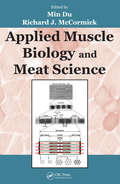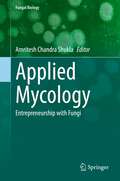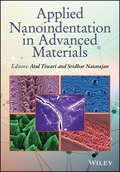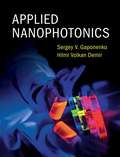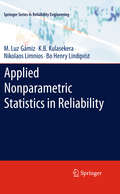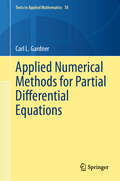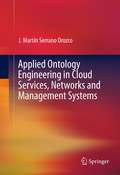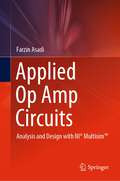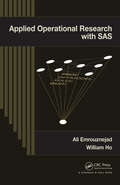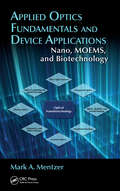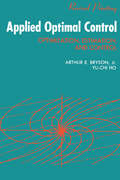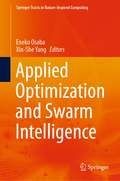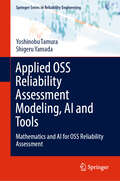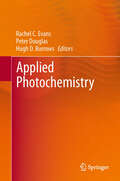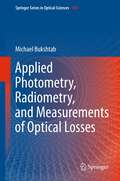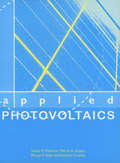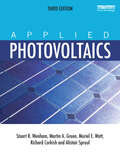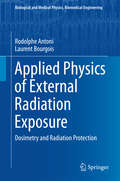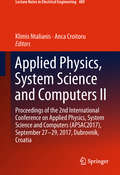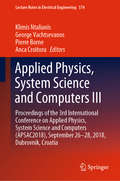- Table View
- List View
Applied Muscle Biology and Meat Science
by Richard J. McCormick Min DuKnowledge of muscle biology is continuing to expand in the animal and food sciences industry, especially the understanding of the mechanisms that control skeletal muscle development, growth, and their impacts on meat production and quality. Applied Muscle Biology and Meat Science provides agriculturalists with state-of-the-art information and a platform to further explore this specialized topic. It also gives novices a comprehensive knowledge base in applied muscle biology and meat science. Many existing problems in meat science and production are due to a lack of understanding of the underlying biological mechanisms of the livestock. Careful to avoid gory processing details, the text focuses on biological changes and the appropriate manage
Applied Mycology: Entrepreneurship with Fungi (Fungal Biology)
by Amritesh Chandra ShuklaFungi are an important link in the food webs of all ecosystems. They have immense potential and comprise a myriad of useful bioactive compounds. Fungi feature in a wide range of diverse processes and applications in modern agriculture, the food science industry, and the pharmaceutical industry. In the food and drink arena, the role of fungi is historically important in the form of mushrooms and in fermented foods as yeasts for baking and brewing. These roles are supplemented by the use of fungal food processing enzymes and additives, and more recently in the development of protein-based foodstuffs from fungi. Additionally, they are used in the formulation of biofertilizers and biopesticides used as biostimulants and bioprotectants of crops. The practical use of newer techniques such as genetic recombination and robotics have revolutionized the modem agricultural biotechnology industry, and have created an enormous range of possible further applications of fungal products.Myco-materials created from mycelia (the root-like parts of fungi) are gaining attention as a sustainable alternative for a wide range of materials. They are being used as insulation, sustainable packaging, foam inserts, and even "eco-leather.” In fact, mycelium bricks are pound-for-pound stronger than concrete. In addition, medicinal uses of fungal species have been historically recorded as important agents in the pharmaceutical sciences. The potential for myco-materials seems limitless. The field of mycology and its application has become an increasingly important component in the education of industrial biotechnology. This book on applied mycology provides information helpful for developing entrepreneurial opportunities with fungi. This volume explains both the basic science and the applications of mycology and bio-resource technology with special emphasis on entrepreneurial applications. It offers a complete, one-stop resource for those interested in microbiology, food and agricultural science, medical mycology, and for those in industrial biotechnology.
Applied Nanoindentation in Advanced Materials
by Atul Tiwari Sridhar NatarajanResearch in the area of nanoindentation has gained significant momentum in recent years, but there are very few books currently available which can educate researchers on the application aspects of this technique in various areas of materials science. Applied Nanoindentation in Advanced Materials addresses this need and is a comprehensive, self-contained reference covering applied aspects of nanoindentation in advanced materials. With contributions from leading researchers in the field, this book is divided into three parts. Part one covers innovations and analysis, and parts two and three examine the application and evaluation of soft and ceramic-like materials respectively. Key features: A one stop solution for scholars and researchers to learn applied aspects of nanoindentation Contains contributions from leading researchers in the field Includes the analysis of key properties that can be studied using the nanoindentation technique Covers recent innovations Includes worked examples Applied Nanoindentation in Advanced Materials is an ideal reference for researchers and practitioners working in the areas of nanotechnology and nanomechanics, and is also a useful source of information for graduate students in mechanical and materials engineering, and chemistry. This book also contains a wealth of information for scientists and engineers interested in mathematical modelling and simulations related to nanoindentation testing and analysis.
Applied Nanophotonics
by Sergey V. Gaponenko Hilmi Volkan DemirWith full color throughout, this unique text provides an accessible yet rigorous introduction to the basic principles, technology, and applications of nanophotonics. It explains key physical concepts such as quantum confinement in semiconductors, light confinement in metal and dielectric nanostructures, and wave coupling in nanostructures, and describes how they can be applied in lighting sources, lasers, photonic circuitry, and photovoltaic systems. Readers will gain an intuitive insight into the commercial implementation of nanophotonic components, in both current and potential future devices, as well as challenges facing the field. The fundamentals of semiconductor optics, optical material properties, and light propagation are included, and new and emerging fields such as colloidal photonics, Si-based photonics, nanoplasmonics, and bioinspired photonics are all discussed. This is the 'go-to' guide for graduate students and researchers in electrical engineering who are interested in nanophotonics, and students taking nanophotonics courses.
Applied Nonparametric Statistics in Reliability (Springer Series in Reliability Engineering)
by Nikolaos Limnios M. Luz Gámiz Bo Henry Lindqvist K. B. KulasekeraNonparametric statistics has probably become the leading methodology for researchers performing data analysis. It is nevertheless true that, whereas these methods have already proved highly effective in other applied areas of knowledge such as biostatistics or social sciences, nonparametric analyses in reliability currently form an interesting area of study that has not yet been fully explored. Applied Nonparametric Statistics in Reliability is focused on the use of modern statistical methods for the estimation of dependability measures of reliability systems that operate under different conditions. The scope of the book includes: smooth estimation of the reliability function and hazard rate of non-repairable systems; study of stochastic processes for modelling the time evolution of systems when imperfect repairs are performed; nonparametric analysis of discrete and continuous time semi-Markov processes; isotonic regression analysis of the structure function of a reliability system, and lifetime regression analysis. Besides the explanation of the mathematical background, several numerical computations or simulations are presented as illustrative examples. The corresponding computer-based methods have been implemented using R and MATLAB®. A concrete modelling scheme is chosen for each practical situation and, in consequence, a nonparametric inference procedure is conducted. Applied Nonparametric Statistics in Reliability will serve the practical needs of scientists (statisticians and engineers) working on applied reliability subjects.
Applied Nonsingular Astrodynamics: Optimal Low-Thrust Orbit Transfer (Cambridge Aerospace Series #45)
by Jean Albert KéchichianThis essential book describes the mathematical formulations and subsequent computer simulations required to accurately project the trajectory of spacecraft and rockets in space, using the formalism of optimal control for minimum-time transfer in general elliptic orbit. The material will aid research students in aerospace engineering, as well as practitioners in the field of spaceflight dynamics, in developing simulation software to carry out trade studies useful in vehicle and mission design. It will teach readers to develop flight software for operational applications in autonomous mode, so to actually transfer space vehicles from one orbit to another. The practical, real-life applications discussed will give readers a clear understanding of the mathematics of orbit transfer, allow them to develop their own operational software to fly missions, and to use the contents as a research tool to carry out even more complex analyses.
Applied Numerical Methods for Food and Agricultural Engineers
by Prabir K. Chandra R. Paul SinghWritten from the expertise of an agricultural engineering background, this exciting new book presents the most useful numerical methods and their complete program listings.
Applied Numerical Methods for Partial Differential Equations (Texts in Applied Mathematics #78)
by Carl L. GardnerThe aim of this book is to quickly elevate students to a proficiency level where they can solve linear and nonlinear partial differential equations using state-of-the-art numerical methods. It covers numerous topics typically absent in introductory texts on ODEs and PDEs, including: Computing solutions to chaotic dynamical systems with TRBDF2 Simulating the nonlinear diffusion equation with TRBDF2 Applying Newton’s method and GMRES to the nonlinear Laplace equation Analyzing gas dynamics with WENO3 (1D Riemann problems and 2D supersonic jets) Modeling the drift-diffusion equations with TRBDF2 and PCG Solving the classical hydrodynamic model (electro-gas dynamics) with WENO3 and TRBDF2 The book features 34 original MATLAB programs illustrating each numerical method and includes 93 problems that confirm results discussed in the text and explore new directions. Additionally, it suggests eight semester-long projects. This comprehensive text can serve as the basis for a one-semester graduate course on the numerical solution of partial differential equations, or, with some advanced material omitted, for a one-semester junior/senior or graduate course on the numerical solution of ordinary and partial differential equations. The topics and programs will be of interest to applied mathematicians, engineers, physicists, biologists, chemists, and more.
Applied Ontology Engineering in Cloud Services, Networks and Management Systems
by J. Martin SerranoMetadata standards in today's ICT sector are proliferating at unprecedented levels, while automated information management systems collect and process exponentially increasing quantities of data. With interoperability and knowledge exchange identified as a core challenge in the sector, this book examines the role ontology engineering can play in providing solutions to the problems of information interoperability and linked data. At the same time as introducing basic concepts of ontology engineering, the book discusses methodological approaches to formal representation of data and information models, thus facilitating information interoperability between heterogeneous, complex and distributed communication systems. In doing so, the text advocates the advantages of using ontology engineering in telecommunications systems. In addition, it offers a wealth of guidance and best-practice techniques for instances in which ontology engineering is applied in cloud services, computer networks and management systems. Engineering and computer science professionals (infrastructure architects, software developers, service designers, infrastructure operators, engineers, etc.) are today confronted as never before with the challenge of convergence in software solutions and technology. This book will help them respond creatively to what is sure to be a period of rapid development.
Applied Op Amp Circuits: Analysis and Design with NI® Multisim™
by Farzin AsadiThis book provides a compact but comprehensive treatment that guides the reader through the important applications of operational amplifiers. The author uses his extensive classroom experience to guide readers toward a deeper understanding of key concepts of operational amplifier circuits. The NI® Multisim™ is used throughout the book to analyze and design the circuits. The book is designed to serve as a textbook for courses offered to undergraduate and postgraduate students enrolled in electrical and computer engineering. The prerequisite for this book is a first course in electric circuits.
Applied Operational Research with SAS
by Ali Emrouznejad William HoUsing a wide range of operational research (OR) optimization examples, Applied Operational Research with SAS demonstrates how the OR procedures in SAS work. The book is one of the first to extensively cover the application of SAS procedures to OR problems, such as single criterion optimization, project management decisions, printed circuit board as
Applied Optics Fundamentals and Device Applications: Nano, MOEMS, and Biotechnology
by Mark A. MentzerHow does the field of optical engineering impact biotechnology? Perhaps for the first time, Applied Optics Fundamentals and Device Applications: Nano, MOEMS, and Biotechnology answers that question directly by integrating coverage of the many disciplines and applications involved in optical engineering, and then examining their applications in nanobiotechnology. Written by a senior U.S. Army research scientist and pioneer in the field of optical engineering, this book addresses the exponential growth in materials, applications, and cross-functional relevance of the many convergent disciplines making optical engineering possible, including nanotechnology, MEMS, (MOEMS), and biotechnology. Integrates Coverage of MOEMS, Optics, and Nanobiotechnology—and Their Market Applications Providing an unprecedented interdisciplinary perspective of optics technology, this book describes everything from core principles and fundamental relationships, to emerging technologies and practical application of devices and systems—including fiber-optic sensors, integrated and electro-optics, and specialized military applications. The author places special emphasis on: Fiber sensor systems Electro-optics and acousto-optics Optical computing and signal processing Optical device performance Thin film magnetic memory MEMS, MOEMS, nano- and bionanotechnologies Optical diagnostics and imaging Integrated optics Design constraints for materials, manufacturing, and application space Bridging the technology gaps between interrelated fields, this reference is a powerful tool for students, engineers and scientists in the electrical, chemical, mechanical, biological, aerospace, materials, and optics fields. Its value also extends to applied physicists and professionals interested in the relationships between emerging technologies and cross-disciplinary opportunities. Author Mark A. Mentzer is a pioneer in the field of optical engineering. He is a senior research scientist at the U.S. Army Research Laboratory in Maryland. Much of his current work involves extending the fields of optical engineering and solid state physics into the realm of biochemistry and molecular biology, as well as structured research in biophotonics.
Applied Optimal Control: Optimization, Estimation and Control
by A. E. BrysonThis best-selling text focuses on the analysis and design of complicated dynamics systems. CHOICE called it ""a high-level, concise book that could well be used as a reference by engineers, applied mathematicians, and undergraduates. The format is good, the presentation clear, the diagrams instructive, the examples and problems helpful...References and a multiple-choice examination are included.
Applied Optimization and Swarm Intelligence (Springer Tracts in Nature-Inspired Computing)
by Eneko Osaba Xin-She YangThis book gravitates on the prominent theories and recent developments of swarm intelligence methods, and their application in both synthetic and real-world optimization problems. The special interest will be placed in those algorithmic variants where biological processes observed in nature have underpinned the core operators underlying their search mechanisms. In other words, the book centers its attention on swarm intelligence and nature-inspired methods for efficient optimization and problem solving. The content of this book unleashes a great opportunity for researchers, lecturers and practitioners interested in swarm intelligence, optimization problems and artificial intelligence.
Applied Optimization in the Petroleum Industry
by Hesham K. AlfaresThe book addresses optimization in the petroleum industry from a practical, large-scale-application-oriented point of view. The models and techniques presented help to optimize the limited resources in the industry in order to maximize economic benefits, ensure operational safety, and reduce environmental impact. The book discusses several important real-life applications of optimization in the petroleum industry, ranging from the scheduling of personnel time to the blending of gasoline. It covers a wide spectrum of relevant activities, including drilling, producing, maintenance, and distribution. The text begins with an introductory overview of the petroleum industry and then of optimization models and techniques. The main body of the book details a variety of applications of optimization models and techniques within the petroleum industry.Applied Optimization in the Petroleum Industry helps readers to find effective optimization-based solutions to their own practical problems in a large and important industrial sector, still the main source of the world’s energy and the source of raw materials for a wide variety of industrial and consumer products.
Applied Optimization Methods for Wireless Networks
by Y. Thomas Hou Yi Shi Hanif D. SheraliWritten in a unique style, this book is a valuable resource for faculty, graduate students, and researchers in the communications and networking area whose work interfaces with optimization. It teaches you how various optimization methods can be applied to solve complex problems in wireless networks. Each chapter reviews a specific optimization method and then demonstrates how to apply the theory in practice through a detailed case study taken from state-of-the-art research. You will learn various tips and step-by-step instructions for developing optimization models, reformulations, and transformations, particularly in the context of cross-layer optimization problems in wireless networks involving flow routing (network layer), scheduling (link layer), and power control (physical layer). Throughout, a combination of techniques from both operations research and computer science disciplines provides a holistic treatment of optimization methods and their applications. Each chapter includes homework exercises, with PowerPoint slides and a solutions manual for instructors available online.
Applied OSS Reliability Assessment Modeling, AI and Tools: Mathematics and AI for OSS Reliability Assessment (Springer Series in Reliability Engineering)
by Shigeru Yamada Yoshinobu TamuraThis textbook introduces the theory and application of open source software (OSS) reliability. The measurement and management of open source software are essential to produce and maintain quality and reliable systems while using open source software. This book describes the latest methods for the reliability assessment of open source software. It presents the state of the art of open source software reliability measurement and assessment based on stochastic modeling and deep learning approaches. It introduces several stochastic reliability analyses of OSS computing with application along with actual OSS project data. The book contains exercises to aid learning and is useful for graduate students and researchers.
Applied Photochemistry
by Peter Douglas Hugh D. Burrow Rachel C. EvansApplied Photochemistry encompasses the major applications of the chemical effects resulting from light absorption by atoms and molecules in chemistry, physics, medicine and engineering, and contains contributions from specialists in these key areas. Particular emphasis is placed both on how photochemistry contributes to these disciplines and on what the current developments are.The book starts with a general description of the interaction between light and matter, which provides the general background to photochemistry for non-specialists. The following chapters develop the general synthetic and mechanistic aspects of photochemistry as applied to both organic and inorganic materials, together with types of materials which are useful as light absorbers, emitters, sensitisers, etc. for a wide variety of applications. A detailed discussion is presented on the photochemical processes occurring in the Earth's atmosphere, including discussion of important current aspects such as ozone depletion. Two important distinct, but interconnected, applications of photochemistry are in photocatalytic treatment of wastes and in solar energy conversion. Semiconductor photochemistry plays an important role in these and is discussed with reference to both of these areas. Free radicals and reactive oxygen species are of major importance in many chemical, biological and medical applications of photochemistry, and are discussed in depth. The following chapters discuss the relevance of using light in medicine, both with various types of phototherapy and in medical diagnostics. The development of optical sensors and probes is closely related to diagnostics, but is also relevant to many other applications, and is discussed separately. Important aspects of applied photochemistry in electronics and imaging, through processes such as photolithography, are discussed and it is shown how this is allowing the increasing miniaturisation of semiconductor devices for a wide variety of electronics applications and the development of nanometer scale devices. The final two chapters provide the basic ideas necessary to set up a photochemical laboratory and to characterise excited states. This book is aimed at those in science, engineering and medicine who are interested in applying photochemistry in a broad spectrum of areas. Each chapter has the basic theories and methods for its particular applications and directs the reader to the current, important literature in the field, making Applied Photochemistry suitable for both the novice and the experienced photochemist.
Applied Photometry, Radiometry, and Measurements of Optical Losses (Springer Series in Optical Sciences #163)
by Michael BukshtabApplied Photometry, Radiometry, and Measurements of Optical Losses reviews and analyzes physical concepts of radiation transfer, providing quantitative foundation for the means of measurements of optical losses, which affect propagation and distribution of light waves in various media and in diverse optical systems and components. The comprehensive analysis of advanced methodologies for low-loss detection is outlined in comparison with the classic photometric and radiometric observations, having a broad range of techniques examined and summarized: from interferometric and calorimetric, resonator and polarization, phase-shift and ring-down decay, wavelength and frequency modulation to pulse separation and resonant, acousto-optic and emissive - subsequently compared to direct and balancing methods for studying free-space and polarization optics, fibers and waveguides. The material is focused on applying optical methods and procedures for evaluation of transparent, reflecting, scattering, absorbing, and aggregated objects, and for determination of power and energy parameters of radiation and color properties of light.
Applied Photovoltaics
by Richard Corkish Martin A Green Muriel E Watt Stuart R WenhamA reliable, accessible and comprehensive guide for students of photovoltaic applications and renewable energy engineering. This thoroughly considered textbook from a group of leading influential and award-winning authors is brimming with information and is carefully designed to meet the needs of its readers. Along with exercises and references at the end of each chapter, the book features a set of detailed technical appendices that provide essential equations, data sources and standards. Starting from basics with 'The Characteristics of Sunlight' the reader is guided step-by-step through semiconductors and p-n junctions; the behaviour of solar cells; cell properties ad design; and PV cell interconnection and module fabrication. The book covers stand-alone photovoltaic systems; specific purpose photovoltaic systems; remote are power supply systems; and grid-connected photovoltaic systems. There is also a section on photovoltaic water pumping system components and design. Applied Photovolatics is well illustrated and readable with an abundance of diagrams and illustrations, and will provide the reader with all the information needed to start working with photovoltaics.
Applied Photovoltaics
by Martin A. Green Stuart R. Wenham Muriel E. Watt Richard Corkish Alistair SproulThe new edition of this thoroughly considered textbook provides a reliable, accessible and comprehensive guide for students of photovoltaic applications and renewable energy engineering. Written by a group of award-winning authors it is brimming with information and is carefully designed to meet the needs of its readers. Along with exercises and references at the end of each chapter, it features a set of detailed technical appendices that provide essential equations, data sources and standards. The new edition has been fully updated with the latest information on photovoltaic cells, modules, applications and policy. Starting from basics with 'The Characteristics of Sunlight' the reader is guided step-by-step through semiconductors and p-n junctions; the behaviour of solar cells; cell properties and design; and PV cell interconnection and module fabrication. The book covers stand-alone photovoltaic systems; specific purpose photovoltaic systems; remote area power supply systems; grid-connected photovoltaic systems and water pumping. Applied Photovoltaics is highly illustrated and very accessible, providing the reader with all the information needed to start working with photovoltaics.
Applied Physics of External Radiation Exposure: Dosimetry and Radiation Protection (Biological and Medical Physics, Biomedical Engineering)
by Rodolphe Antoni Laurent BourgoisThis book describes the interaction of living matter with photons, neutrons, charged particles, electrons and ions. The authors are specialists in the field of radiation protection. The book synthesizes many years of experiments with external radiation exposure in the fields of dosimetry and radiation shielding in medical, industrial and research fields. It presents the basic physical concepts including dosimetry and offers a number of tools to be used by students, engineers and technicians to assess the radiological risk and the means to avoid them by calculating the appropriate shields. The theory of radiation interaction in matter is presented together with empirical formulas and abacus. Numerous numerical applications are treated to illustrate the different topics. The state of the art in radiation protection and dosimetry is presented in detail, especially in the field of simulation codes for external exposure to radiation, medical projects and advanced research. Moreover, important data spread in different up to date references are presented in this book. The book deals also with accelerators, X-rays facilities, sealed sources, dosimetry, Monte Carlo simulation and radiation regulation. Each chapter is split in two parts depending on the level of details the readers want to focus on. The first part, accessible to a large public, provides a lot of simple examples to help understanding the physics concepts under radiation external exposure. The second part, called "Additional Information" is not mandatory; it aims on explaining topics more deeply, often using mathematical formulations. The book treats fundamental radiometric and dosimetric quantities to describe the interaction in materials under the aspects of absorbed dose processes in tissues. Definitions and applications on limited and operational radiation protection quantities are given. An important aspect are practical engineering tools in industrial, medical and research domains. Source characterization and shielding design are addressed. Also more "exotic" topics, such as ultra intense laser and new generation accelerators, are treated. The state of the art is presented to help the reader to work with the book in a self-consistent way. The basic knowledge necessary to apply Monte Carlo methods in the field of radiation protection and dosimetry for external radiation exposure is provided. Coverage of topics such as variance reduction, pseudo-random number generation and statistic estimators make the book useful even to experienced Monte Carlo practitioners. Solved problems help the reader to understand the Monte Carlo process. The book is meant to be used by researchers, engineers and medical physicist. It is also valuable to technicians and students.
Applied Physics, System Science and Computers II: Proceedings of the 2nd International Conference on Applied Physics, System Science and Computers (APSAC2017), September 27-29, 2017, Dubrovnik, Croatia (Lecture Notes in Electrical Engineering #489)
by Klimis Ntalianis Anca CroitoruThis book reports on advanced theories and methods in three related fields of research: applied physics, system science and computers. It is organized in three parts, the first of which covers applied physics topics, including lasers and accelerators; condensed matter, soft matter and materials science; nanoscience and quantum engineering; atomic, molecular, optical and plasma physics; as well as nuclear and high-energy particle physics. It also addresses astrophysics, gravitation, earth and environmental science, as well as medical and biological physics. The second and third parts focus on advances in computers and system science, respectively, and report on automatic circuit control, power systems, computer communication, fluid mechanics, simulation and modeling, software engineering, data structures and applications of artificial intelligence among other areas. Offering a collection of contributions presented at the 2nd International Conference on Applied Physics, System Science and Computers (APSAC), held in Dubrovnik, Croatia on September 27–29, 2017, the book bridges the gap between applied physics and electrical engineering. It not only to presents new methods, but also promotes collaborations between different communities working on related topics at the interface between physics and engineering, with a special focus on communication, data modeling and visualization, quantum information, applied mechanics as well as bio and geophysics.
Applied Physics, System Science and Computers III: Proceedings of the 3rd International Conference on Applied Physics, System Science and Computers (APSAC2018), September 26-28, 2018, Dubrovnik, Croatia (Lecture Notes in Electrical Engineering #574)
by Pierre Borne Klimis Ntalianis Anca Croitoru George VachtsevanosThis book reports on advanced theories and methods in three related fields of research: applied physics, system science and computers. The first part covers applied physics topics, such as lasers and accelerators; fluid dynamics, optics and spectroscopy, among others. It also addresses astrophysics, security, and medical and biological physics. The second part focuses on advances in computers, such as those in the area of social networks, games, internet of things, deep learning models and more. The third part is especially related to systems science, covering swarm intelligence, smart cities, complexity and more. Advances in and application of computer communication, artificial intelligence, data analysis, simulation and modeling are also addressed. The book offers a collection of contributions presented at the 3nd International Conference on Applied Physics, System Science and Computers (APSAC), held in Dubrovnik, Croatia on September 26–28, 2018. Besides presenting new methods, it is also intended to promote collaborations between different communities working on related topics at the interface between physics, computer science and engineering.
